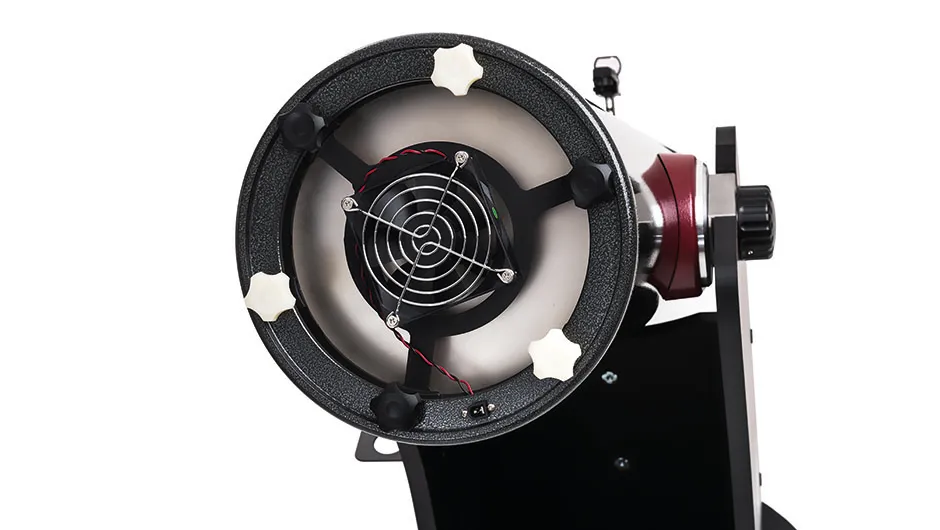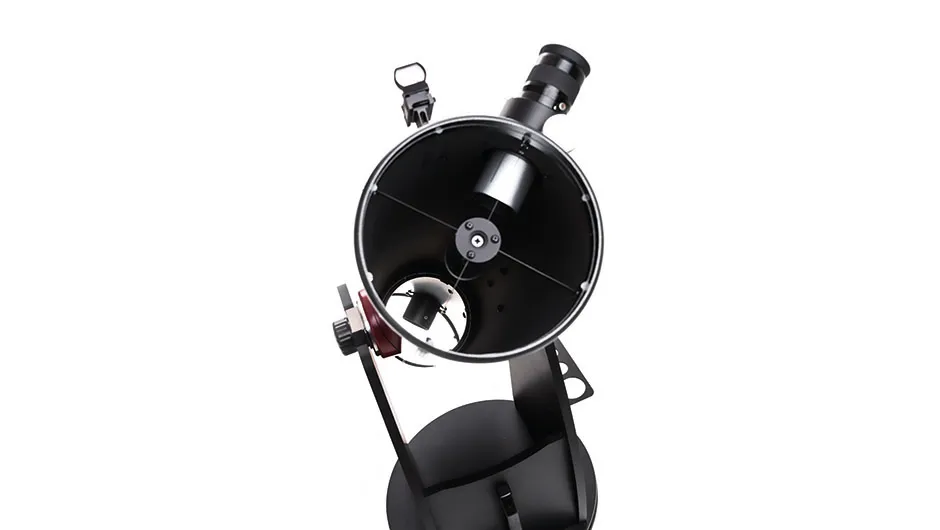This 8-inch Dobsonian scope from Omegon is a member of its ProDob range that also includes versions with 10-inch (254mm) and 12-inch (304mm) diameter mirrors (£670 and £850 respectively).
The instrument came well packed in two cardboard containers.One long box contained the preassembled optical tube, while another squat, package held the parts to build the rocker box mount.
Assembly mainly consisted of putting the particle board rocker box together which was intuitive and straightforward.
Clear instructions are provided but they are limited to the assembly; there’s little information on using the scope and none on collimation, a vital part of setting up a Newtonian reflector.
But we did manage to collimate the scope and once done, it held alignment quite well.
A 32mm super wide angle eyepiece, mirror-cooling fan, battery box and a red dot finder complete the system.
Setting up the scope to observe at night was so easy that we got the scope out several times just for a quick 10-minute observing session.
The rocker box is reasonably light and has a handle to help lug it to an observing spot.
You can carry the scope by the two altitude bearings, which then drop into the U-shaped cut-outs in the rocker box.
Remove the tube’s front cover, switch on the finder, drop in an eyepiece and you’re ready to observe – all in about two minutes from start to finish!

Fine-detail focussing
Our first session with the scope was on a steady night a few weeks before solstice, a period when it never gets really dark.
The scope had been stored in an outside garage, so it needed very little cooling before use.
The first object we targeted was Jupiter at 20° altitude using our own 7mm Nagler eyepiece. Wow!
The planet snapped into focus and showed lots of belt and spot features with deep contrast, an indication of fine optics.
Next, with the same eyepiece, M13, the Great Globular Cluster in Hercules, looked glorious with loads of stars, while the famous double binary Epsilon Lyrae was perfectly defined, the four components cleanly split and the stars’ airy discs clean and round.
With the supplied 32mm eyepiece giving a wider field of view we swept up to M57, the Ring Nebula, which again was captivating – nicely defined and sitting among a lovely sea of faint summer stars.
On other nights we achieved similar results, with the scope’s high-contrast optics producing great views of deep-sky objects and making the Moon in particular quite mesmerising.
We even had hints of the Veil Nebula on solstice night with an OIII filter screwed into our 16mm Nagler eyepiece.
On opposition night, at only 10° altitude, Saturn was a glorious sight in surprisingly steady skies, showing a dusky, darker equatorial belt and a clear Cassini division in the rings.
Star testing later showed a very similar defocussed star image either side of focus indicating a smooth and nearly perfect parabolic shape to the primary.
Apart from the great optics we were impressed with the friction control on the altitude and azimuth axes which really helped make the scope easy to use.
It’s nice to find that a fairly simple and straightforward piece of equipment has been so well designed and solidly built.
We would have no hesitation in recommending the Omegon ProDob N 203/1200 for beginners as well as those more experienced astronomers who want a good simple scope to reconnect with the skies.

Outstanding feature: Smooth altitude and azimuth bearings
The design of the altitude and azimuth bearings plays a big part in the ease of use of a Dobsonian.
The friction of the bearings needs to be just right; they also need to have a smooth feel with minimal ‘stiction’, otherwise it would make it hard to follow objects as drifting slowly across the night sky by making small incremental nudges.
This is all quite difficult to achieve in a big scope and even harder in a small, lightweight scope where there is little downwards force.
For azimuth movement the scope uses a large ‘lazy Susan’-type bearing.
Normally such bearings are too light but Omegon corrects this with a friction control knob at the centre which allows you to add compression to the bearing and increase the friction.
The altitude bearings are similarly adjustable and are wonderful and attractive pieces of engineering.
As well as being able to adjust the friction you can move them up or down the tube to improve the scope balance; a great feature.
Omegon has done a great job with the bearings on this scope.

Primary mirror cell
The primary mirror is supported on three pads in a well-designed black aluminium mirror cell.
There is a low-vibration fan blowing on the rear of the mirror.
The fan is powered by eight AA batteries and it dramatically reduces mirror cool-down times.
For collimation the cell is adjustable using a simple push-pull design with six plastic thumb knobs.
Finder
The scope comes with a red (or green – you have the option to swap) dot finder.
The dot has adjustable brightness, although at night we always used it on the lowest red dot setting.
The direction is adjustable, but we found the spring pressure poor over half its range, which made lining it up with the main scope a little difficult.
Primary mirror
Sitting in its cell at the bottom of the black steel optical tube is the 8-inch (203mm), f/6, parabolic primary mirror.
This has enhanced reflectivity front coatings and a fine-ground rear face.
Placed at the exact centre of the front face is a black marker ring for much easier collimation when you use the right tools (not included).
Secondary mirror and holder
The secondary mirror is glued to a black aluminium holder, which is held by the spider’s central boss and a single screw.
Three cross-head push screws allow adjustment of the mirror orientation during collimation.
The whole assembly is a well-made version of a traditional and well-proven design, although a no-tool version would have been a welcome improvement.
Focuser
The focuser is a handsome dual-speed Crayford design with a smooth action and a positive feel with no slip or play in it.
The focuser has a lock on the barrel and will take 2-inch eyepieces, as well as 1.25-inch ones with the supplied adaptor, which is also T-threaded.
Vital stats
- Price £530.00
- Aperture 8-inch
- FocalLength 1,200
- Eyepieces 32mm SWAN wide-field 2-inch eyepiece
- Weight Base 12.3kg, tube 11.3kg
- Supplier Omegon
- Telephone+49 8191 940490
- www.omegon.eu
This review originally appeared in the September 2018 issue of BBC Sky at Night Magazine
